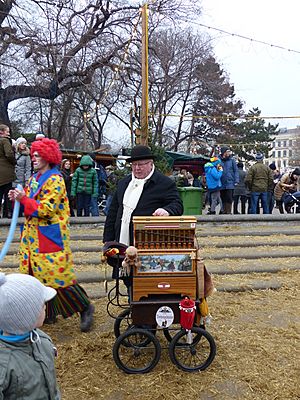Street organ facts for kids
A street organ is a special kind of musical instrument that plays music automatically. It's like a small, portable mechanical organ designed to be played outdoors, often in the street. The person who plays it is called an organ grinder. You might see smaller German street organs or larger Dutch ones.
The History of Street Organs
The first street organs were called barrel organs. They used a spinning cylinder, or "barrel," with pins on it. These pins would push levers to play different notes. People started writing about these organs in the late 1700s. Many were built by Italian organ makers who moved to France and Germany.
These early organs were bigger than smaller instruments like the serinette. They could play more than one song. Some were quite large, about 75 cm (29 inches) long. They often had decorative parts and extra pipes for different sounds.
In many European towns, the barrel street organ wasn't just played alone. It was often part of a street show with other musicians. They would tell stories, use colorful posters, and encourage people to sing along. In New York City, many Italian immigrants arrived, and by 1880, a lot of Italian men worked as organ grinders.
However, the barrels were heavy and could only hold a few songs. It was hard to update them with new popular music. This made them less useful over time.
In New York, where organ grinders often had monkeys, the mayor Fiorello La Guardia banned street organs in 1935. He said they caused traffic congestion and that the job involved asking people for money. This ban sadly led to many organs being destroyed. Their barrels held recordings of popular music from that time. Before cylinder records were invented, these barrels were often the only way to keep a record of these tunes. The ban was lifted in 1975, but by then, street organs were no longer common.
Many cities in the United Kingdom also had rules against organ grinders. Police sometimes treated them like people asking for money or causing a public nuisance.
In the Netherlands, street organs weren't popular at first either. But some companies rented out organs and took great care of them. They made sure the organs sounded good and had a wide range of songs. Because of this, people in the Netherlands started to like the orgelman (organ man). Playing organs on the street became a part of Dutch culture and was common until the early 2000s. Now, they are rarely seen.
In Paris, there were only a limited number of permits for organ grinders. You had to wait a long time or be very experienced to get one.
One big reason organ grinders disappeared from European streets was new copyright laws. In the late 1800s and early 1900s, music publishers and owners of popular songs started to demand payment. They wanted money from any musician who played their songs in public. When organ grinders faced these legal demands, along with other problems, they soon stopped playing in the streets.
Who Were Organ Grinders?

An organ grinder was a street performer who played a street or barrel organ. They were popular in the 1800s and early 1900s.
Sometimes, old stories or newspapers described organ grinders as tricky people or as poor people. Some reporters joked that they were paid to stop playing their often-repeated music! Later, people started to see them in a more romantic or charming way. While some organ grinders traveled a lot, many, especially in New York, were Italian immigrants. They became street performers to support their families.
The typical organ grinder was a man. He would carry a medium-sized barrel organ in front of him. It was held up by a wooden stick or leg and a strap around his neck. This left one hand free to turn the crank and the other to steady the organ. They often had a tin cup on top of the organ or in a companion's hand to collect money.
However, street organs came in many sizes. Some were tiny barrel organs with only 20 pipes, weighing just a few pounds. Others were medium-sized with 40 or more pipes, moved on a trolley. The largest ones were big, fancy organs that used special "books" of music. These could have hundreds of pipes and weigh hundreds of pounds. The biggest organs were usually on a cart and needed a team of people to move them. This was especially true in the Netherlands, where they had to cross steep canal bridges in Amsterdam. The most elaborate organs sometimes had mechanical figures or automata on top, along with drums or other percussion instruments.
Images for kids
-
The Dutch street organ Australia Fair, viewed from the front on a street corner in Sydney, Australia.
-
Street Organ showing full size (with people to show scale) at Floriade (Canberra) in 2013
See also
 In Spanish: Organito para niños
In Spanish: Organito para niños






